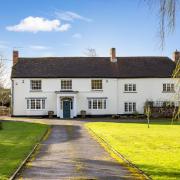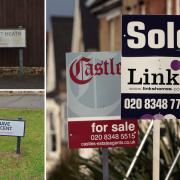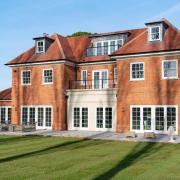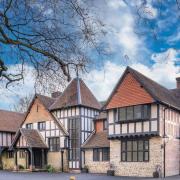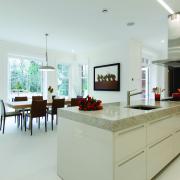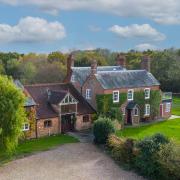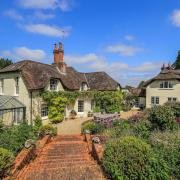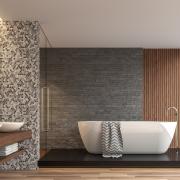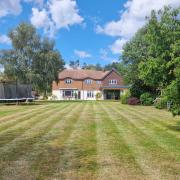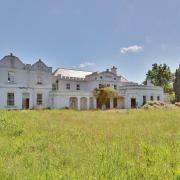What’s so special about the Uplands Estate - a quiet cul-de-sac near Southampton Common? Resident Gordon Cooper shares the story

“We were looking for a house to buy in Southampton, took a walk through the Uplands estate and thought immediately that we just had to live there. We’d lived in the city for seven years and didn’t know it existed until then.”
Ali and Jo Tavassoli, like many couples before them, wanted to start a family and were drawn to Uplands by “the clean design lines, the symmetry, the lack of ornamentation, the wide streets and the trees.” And they liked the idea of owning “a house that looks like a house. If a child were to draw a house these buildings are what it would look like.”
The buildings in question are a collection of around 90 houses built in the 1920’s and 1930’s in Highfield, bordering Southampton Common yet only a mile and a half from the city centre. They were designed by the architect Herbert Collins, who came to live near the estate, and were described by the architectural critic Nicklaus Pevsner as “the best piece of suburbia in Southampton”.
Known locally as “the Collins Houses” the estate is one of the few groups of houses in the region still identified by the name of the man who designed it. The lay-out of the estate was influenced by the Garden City Movement, reflecting a more rural feel through the use of grass verges, brick pavements and front gardens. Each house was of simple design and wider than it was deep, allowing for more windows supplying lots of natural light. And each came with restrictive covenants which still have a strong influence on the way the estate looks today.

They were originally sold in the thirties as “Ideal Labour-Saving Houses” and an early sales brochure points to the “high class finish” of enamel paint which “will withstand constant washing”, and to the stained woodwork “being transparent and thus showing the beauty of the grain of wood”. Built-in dressers were included with glazed upper cupboards and the fixtures and fittings reflected the Arts and Crafts Movement ideal of having “nothing in your houses that you do not know to be useful, or believe to be beautiful.”
Most of the houses were terraced or semi-detached and featured a living room, dining room and a smallish kitchen by modern standards. Upstairs two large bedrooms and one small one was common, with a separate WC and bathroom.
Move forward eighty years or so and the outward appearance of Uplands has changed little since the houses were built. The windows remain intact, external painting is uniform and the original pathways, fencing and verges are much the same as when the estate was first laid out.
“It’s all about control,” according to Collins biographer Robert Williams, “Collins had this architectural vision and he wanted to keep it that way. He was concerned about some of the poor standards of housing design brought about by the speculative building boom and ribbon development of the twenties and thirties.”

In order to protect his legacy Collins arranged to sell the Uplands houses on a 999 year lease with a series of restrictive covenants. Exterior development was restricted and house owners were required to paint interiors every seven years, exteriors every three years and colours and exterior fittings were required to remain the same. Residents were also not allowed to hang washing in the garden on a Sunday or after midday on weekdays! Such eccentric restrictions were not in later years enforced, but the covenants affecting building development and appearance remain. A committee made up of volunteer Uplands residents meets monthly to administer the care and maintenance of the estate and to consider individual development proposals from house owners, which often include plans to knock down walls and install modern plumbing.
Small extensions are allowed at the rear of the properties, but they tend not to be as large as the permitted development in less regulated areas. Robert Williams, himself a conservation architect, thinks that Collins houses are extremely adaptable and that some internal walls can be removed without destroying the Collins ethos. But he cautions against making hasty decisions. “They should be upgraded with care. People should live in the houses for a while before making development plans because once features such as dressers or fireplaces are gone, they are gone for ever.”
Issues relating to improvement and maintaining architectural heritage are not always clear-cut, and the Uplands estate committee treads delicate lines of opinion between conservation and development. Not long after coming to live on the estate, Ali Tavassoli joined the committee.
“I care about how the estate looks. Collins did a great job in blending the houses into the landscape and the actions of individual house owners can affect that vision. Often the committee has robust discussions about individual proposals but seeks consultation about proposed developments. In the end it’s always motivated by conservation.”

The conservationists argue that they are not trying to create an architectural museum but that preserving the Collins legacy can still support a place where neighbourliness, human contact and family life are given room to prosper.
In 1960, Cynthia Donaldson moved into a house on Uplands with her two children under five. “We liked the layout, the open spaces and the trees. I used to know almost everybody on the estate and there was a good mix of young and old. I’ve always loved it here and still do.” Some fifty years later Emily Trumpleman moved in next door to Cynthia with two children under five and makes similar comments, “The open spaces give rise to conversations with neighbours and it’s great to have contact with the young families around as well as looking out for the older people.” And like many others she and her husband have gained approval to extend the house and knock down the wall between the kitchen and dining room to create a space where you can, “chat, cook, watch over the kids and have people in.” Emily accepts that although developing her house was subject to stricter rules than elsewhere, the outcomes will suit the needs of her growing family. “It’s pretty special here,” she says, “and I can see us staying for a long time.”
Despite remaining a suburban secret the Uplands estate quickly becomes known to serious house hunters in Southampton, so there is strong competition to buy. Estate Agent Rodney Vatter from Morris Dibben has been handling Collins houses for twenty years. “It’s a Collins house before anything else. The name gives it status before you walk in. It doesn’t matter whether it’s terraced or semi-detached.” He keeps a book of people wishing to buy and says that some have waited years to find the right property. Most recently the largest and most expensive houses have broken the former £500,000 stamp duty threshold.
Such enthusiasm to buy means that the estate has a ready stream of people willing to invest. In addition, the covenants espoused by Collins have been effective in maintaining much of its architectural integrity. Looking to the future it remains to be seen how ideals forged in an age of paternalism survive into the individualistic times we have come to inhabit.
***
READ ON
• 7 garden trends to expect in 2015 - Garden designer Anne Keenan of Goodworth Clatford shares her predictions for 2015 trends.
• Transforming an old farmhouse to a glamorous family home - A welcoming committee of prettily speckled guinea fowl rush forwards to greet me, fussing excitedly. They’re followed by a beaming Caitlin Russell, who gathers me into her home.
• General election 2015 in Hampshire - candidates and constituencies - The next general election in the UK takes place on Thursday 7 May 2015. We’ve put together a handy Hampshire guide to polling day; including candidates for each constituency and the results from 2010.




